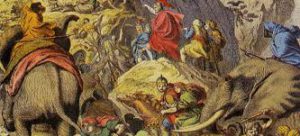Rome, the Punic Wars, World War Two and the USA
[AdSense-A]
Imagine a conflict that consumes the known world. A conflict that spread to the very borders of civilization itself and then consumes it. A conflict that saw combat in all the known continents and left none of them unchanged. A conflict who none could predict the result of and at one point every faction involved thought themselves on either the brink of victory or the edge of defeat. What conflict am I describing? A modern human would probably equate such statements of turmoil and chaos to be attached to either World War One or World War Two. But long before Hitler or Churchill. Long before Bismarck or Wilson. There was Regulus and Xanthippus. There was Scipio and Hannibal.
For those who are unfamiliar with Punic Wars, they were conflict fought between the dominate power of the western-Mediterranean (Carthage) and an upstart city in Italy called Rome. There were a total of three Punic Wars spreading from 264 BC to 146 BC. They are largely considered the most violent wars of the Roman Republic and by the end Rome had gone from a wealthy city-state to the premier power in the Mediterranean. A meteoric rise of power that for centuries remained without rival.
Prior to the World Wars, America was a largely agriculturally based society. While the United States seemed to hint at imperial desires with claims to various territories across the Caribbean and Pacific, these claims were more loose and often small ports were the only sign of any American presence. The roaring 20s brought wealth to America but it was proven unsustainable and eventually the United States barely limped into World War Two, with an Army of only 180,000 soldiers at the onset of the war. For perspective, Portugal had a larger military force at the start of World War Two. By the end of World War Two America had the second largest standing army in the world (second only the massive Red Army of the Soviet Union) and by far the best equipped. American power boomed and the once occasional port of influence was replaced by a global base network rivaled by none.
So the comparison is there, but why make it? What can a Roman victory tell us about an American era of chaos? It all starts and ends with culture. Prior to the Punic Wars, Rome was an emerging Republic. The wars they had fought were largely defensive in nature with Roman expansion limited to the Italian peninsula. Following the Punic Wars Rome had boomed to preliminary power of the Mediterranean. The wealth of Carthage flooded Rome and slowly Romans began to view themselves in the light of supremacy.
Now lets talk post-war America. The emerging Republic of America was no longer emerging. It had arrived on the international stage as no nation before ever had. It is hard to overstate the supremacy America had over other nations following World War Two. Quite literally, never before, nor since, has the earth seen a nation out pace its competitors so intensely. Manufacturing, healthcare, infrastructure, military might, economic production¬—all saw America rise to #1.
Following the Punic Wars, Rome entered an era of intense expansion. The military might of Rome boomed as a culture that once prided itself on Republic ideals instead turned to authoritarianism. For the following century Rome became ever more wealthy and ever more corrupt. Republican ideals were touted vocally but never truly aligned with. Steadily the patrician class turned from paid plebeians to slaves from the numerous conquests of Rome. Meanwhile, the out of work plebian class grew ever poorer.
America’s time at world’s #1 in everything was short lived. Within a decade America’s original sin poked a thousand holes in any sort of American supremacy belief. The following decades were defined by militarization, social conflict, and the further concentration of wealth. In 1963, the average American lower class household had “no wealth.” By 2016 that same slice of population was on average $1,000 in debt. By comparison, over that same time period, the American upper class increased their wealth five times over. And the wealthiest Americans saw a sevenfold increase in their wealth.
The era referred to as the “Roman Transition” did not see the end of Rome. It saw the end of the Roman Republic and the beginning of the Roman Empire. It was the result of militarization, nationalism, and a massive wealth gap. Under this light let us turn to an America that spends more on its military than any other nation ever has, an America whose politicians tout “America First” and an America plagued by a wealth gap as not seen since 19th century France. The plebians of Rome did not rise against their patrician lords. They chose other patricians to follow blindly, and the result was the loss of their Republic.
As Americans, let us not so eagerly make the same mistake.
[si-contact-form form=’2′]


